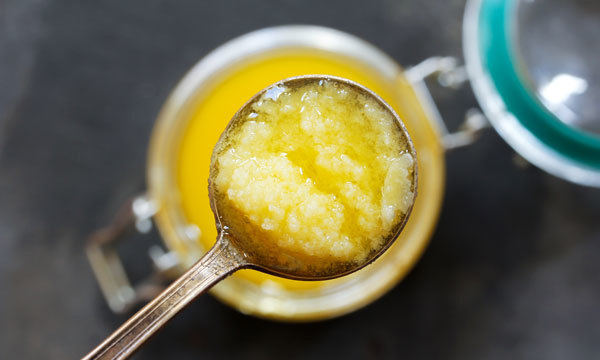
Ghee is one of those ingredients I seem to hear about all the time, but, until recently, knew relatively nothing about. I knew that it was a staple in Indian and Middle Eastern cuisines, and that some people even liked to put it in coffee... and that's about it. But when my cookbook club recently decided to undertake Madhur Joffrey's Vegetarian India for our monthly selection, I decided to finally investigate: just what is ghee, anyway? And what makes it so different from regular butter, or any other cooking fat, for that matter?
Follow along as I attempt to get to know butter's nuttier, purified cousin.
What is ghee?
Like clarified butter, ghee is butter that has been slowly cooked until the milk solids and water have separated, leaving behind only the pure butterfat. The difference between clarified butter and ghee, however, is that, in the making of clarified butter, the separated milk solids are skimmed away and discarded. In the making of ghee, however, the milk solids are left behind, and the butter is allowed to simmer longer until all the water has evaporated and the milk solids have browned.
What does ghee taste like?
The extra time on the stove gives ghee it's signature toasted, nutty flavor. Other than that, it tastes a lot like regular butter, just less creamy.
Ghee vs butter: what's the difference?
Because it's had all its milk solids removed, ghee lasts much longer than butter and is also shelf-stable, meaning it doesn't need to be kept in the refrigerator. It also has a much higher smoke point than butter—ideal if you're planning to cook on high heat. The removal of the milk solids also means that ghee is an approved cooking fat in non-dairy eating plans, such as the Paleo diet, and may be better tolerated by those who are lactose intolerant.
What are some common uses for ghee?
Ghee is a common ingredient in many Indian recipes. And while you could technically use butter in any Indian recipe with adequate results, the nutty flavor imparted by the ghee is key to a truly authentic flavor. But aside from Indian cooking, ghee is ideal for sauteing vegetables and searing mean, and makes a delicious spread for toast and other baked goods. You can also use it in place of other cooking oils, such as vegetable or coconut, when baking.
But ghee may also make a good addition to your healthy and beauty regimen too. Ayurvedic practitioners often mix it with honey to treat scraps and burns, while it can also be used as a mask for hair or as a topical treatment for dry skin.
Where can I buy ghee?
You can purchase pre-made ghee in the ethic foods aisle of virtually any grocery store, but it's also very easy to make at home.
How to make ghee:
Step 1: Place several sticks of high-quality, unsalted butter in a small saucepan and melt over low heat.
Step 2: Continue to cook until butter starts to bubble and a foam forms at the top.
Step 3: Using a spoon, skim away the foam and discard. Continue cooking the butter on low until the milk solids sink to the bottom of the pan.
Step 4: Continue cooking until the sunken milk solids begin to turn color. You want them browned, not brunt, so pay careful attention.
Step 5: Once the solids have browned, remove pan from heat. Strain the mixture through cheesecloth to remove any remaining solids, and store, covered, at room temperature.
